20 Instant Classics From The Intel Developer Forum
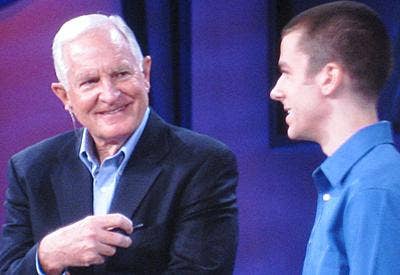
Intel chairman Craig Barrett, left, chats with young Brian McCarthy, third-place finisher in Intel's Science Talent Search competition, during Barrett's opening keynote at last week's Intel Developer Forum in San Francisco. The former Intel CEO kicked off IDF last Tuesday with a keynote emphasizing the need to foster education in math and science to ensure the development of young technology innovators like McCarthy, who won a $50,000 college scholarship from Intel thanks to his work on plastic solar cells.
Barrett, who stepped up to keynote for vacationing Intel CEO Paul Otellini, didn't mince words about the state of education and research in the United States. His take: the current government has failed to commit the money and resources needed to cultivate innovation in high-tech disciplines and compete with European and Asian countries in the years to come.
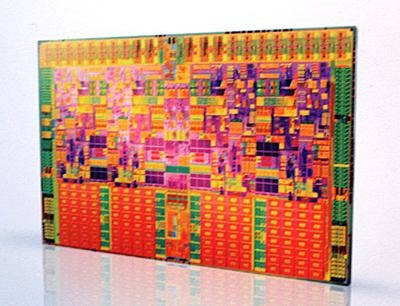
Intel's Pat Gelsinger on Monday officially unveiled the Santa Clara, Calif.-based chip giant's latest microprocessor advance, the new microarchitecture codenamed Nehalem. The Nehalem die, pictured here, features integrated memory controllers -- visible at the very top of this quad-core chip -- eliminating the Front Side Bus on Intel's current Core architecture. Nehalem client processors have been branded "Core i7," while upcoming server chips will retain the Xeon brand name, Intel confirmed at IDF.
Intel says it will ramp production of both its first Core i7 chip, a 3.2GHz, quad-core "Extreme Edition" desktop processor, and a DP Xeon featuring the Nehalem microarchitecture before the year is out. Gelsinger, GM of Intel's Digital Enterprise Group, served up a few specifics about Nehalem during his IDF keynote -- perhaps the most exciting of which is Dynamic Power Management, which "dramatically reduces" power leakage thanks to a process advance and new integrated microcontroller, and which also enables Nehalem's "Turbo Mode," which Gelsinger described as a process by which Intel is able "to take power savings and put it back into performance."
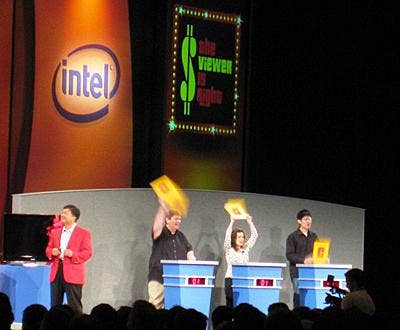
Eric Kim, Intel's Digital Home Group chief, plays the Bob Barker role for a game show segment during his IDF keynote announcing a new Internet television collaboration between the chip maker and Yahoo. The upshot: Intel will supply CE 3100 "media processors" for purpose-built set-top boxes and digital TVs that can run Yahoo's new Widget Channel, a simple Internet browser that runs on television sets concurrently with regular TV broadcasts.

Kim and Yahoo VP of ConnectedTV Patrick Barry did a live demo of the Widget Channel at IDF Tuesday, with Barry clicking through Yahoo's Widget Gallery, showing assorted "snippets" that provided simple weather, news, sports and stock market feeds, and dragging the browser to a sidebar position (as pictured) and then to full screen with apparent ease.
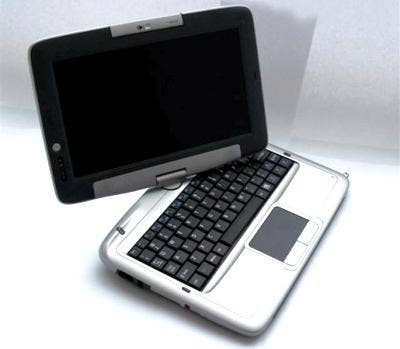
Intel offered a sneak peak at its next Classmate netbook design at the Intel Developer Forum. Next-gen Classmates, which Intel says will ship by the end of the year, turn the low-power, Web-connected notebooks aimed at young students into Tablet PCs with swiveling touch-screen displays.
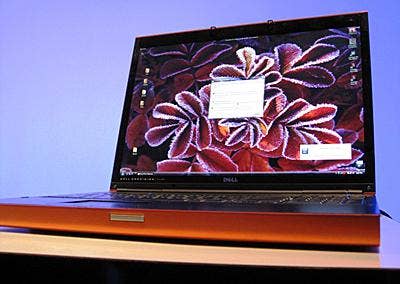
Another big presence at IDF was Centrino 2, Intel's new notebook platform launched earlier in the summer. The latest mobile hardware from Intel, formerly codenamed Montevina, powers new notebook offerings from regional system builders and top OEMs like Dell, which in mid-August showcased its latest line of Latitude commercial laptops (pictured).
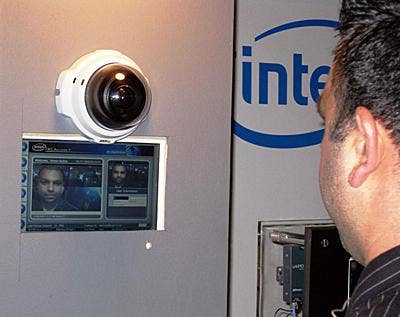
Intel's big push into the consumer electronics and embedded markets was a major theme at IDF. Here, a representative for Haifa, Israel-based Ex-Sight.com demonstrates his company's facial recognition system for the digital home. Ex-sight.com's products didn't just find a place on the show floor -- they were featured on stage during Pat Gelsinger's keynote as well.
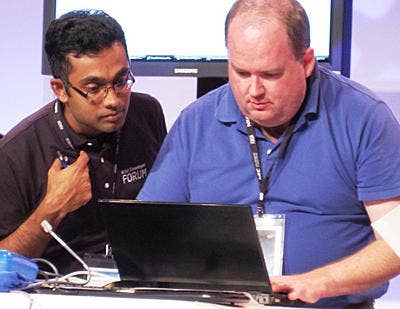
Ken Haugen of Boise, Idaho, races through the paces on his way to taking home the IDF "Ultimate Geek" crown for the second straight year. In a race against time, Haugen and four other contestants, trimmed down from dozens who participated in an earlier trivia challenge, battled to build a notebook, boot up Windows and ping a server while navigating various password encryption puzzles. For demonstrating first-place IT smarts, the MPC engineer rode away from IDF in a $30,000 Smart Car.

Enquirer reporter Charlie Demerjian finished second in Intel's "Ultimate Geek" competition -- apparently for the third straight year, according to his pals in the crowd. Sorry, Charlie -- no Smart Car for you, but at least you're taking home a $5,000 Alienware laptop.
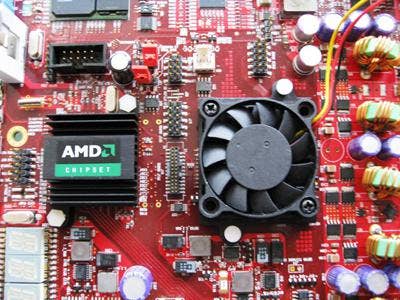
Wait a minute -- what's an AMD chipset doing at the Intel Developer Forum? Well, this new server board from Advanced Micro Devices featuring the "Fiorano" chipset wasn't really at IDF. It was showcased across the street from San Francisco's Moscone Center at the W Hotel, where AMD set up shop early last week to take some wind out of its larger rival's sails. According to AMD server/workstation executive John Fruehe, AMD is going to ramp its 45nm "Shanghai" products before Intel gets its new "Nehalem" chips to the channel. Time will tell.

More from the show floor: This notebook docking station from Calgary-based Cool IT Systems dissipates heat by blowing chilled air at your latptop through a hole at its base, sort of like those hand-blowers at bowling alleys.
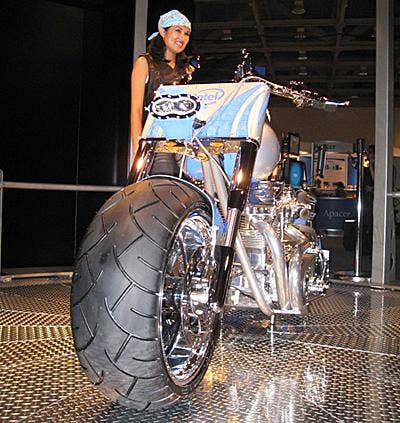
The Intel Chopper was a centerpiece on the show floor at IDF. Kitted out with the latest Intel hardware for navigation, entertainment and other applications, we're guessing it gets roughly 3.2GHz to the gallon.
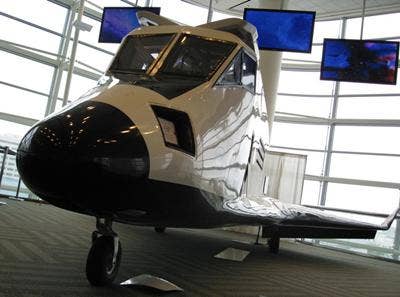
The Hermes Spacecraft is engineer Morris Jarvis' baby -- a prototype mini-space shuttle he says was "built on the premise that anyone who wants to should be able to take a trip into space." Well, anybody who can afford to fork over "the price of a new car" for that trip, which is what Jarvis envisions trips on the Hermes costing. Jarvis and the Hermes team will be conducting unmanned, tethered flights in the coming months, followed by manned test flights. "Morris would love to hear from any volunteers," reads the Hermes literature. Hermes systems include the Intel EP80579 Integrated Processor and Atom chips, hence the mini-shuttle's prominent place at IDF.
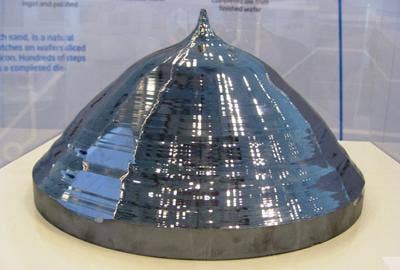
This 12-inch purified silicon ingot tip was part of Intel's historical rotunda at IDF, featuring various exhibits and timelines chronicling the chip giant's computing milestones. Intel recently celebrated the 40th anniversary of its incorporation.
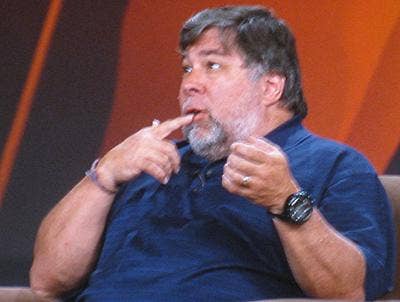
Apple co-founder Steve Wozniak reflects upon his well-documented life during a live IDF radio interview with Tech Nation host Moira Gunn. In addition to regaling the audience the tale of his Silicon Valley success, Wozniak recounted the hijinks of his youth in Silicon Valley -- apparently young Woz got up to mischief like teaching his juvie cellmates how to electrify the cell bars via the ceiling fan and jerry-rigging a TV signal disruptor to mess with clueless Ed Sullivan viewers. But Wozniak insists he's changed his ways -- and he most emphatically did not cut in line to buy an iPhone.
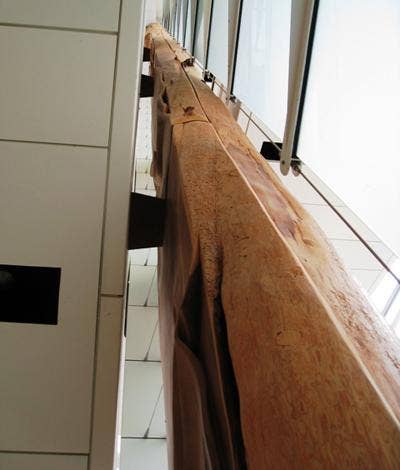
At the very back of Moscone West stands "Tree," a towering sculpture carved from a redwood that rises from the ground floor staircase to the third story of the convention hall. Carved by Hilda Shum, Po Shu Wang and David Gordon, the sculpture was commissioned "to reveal the honor and essence" of a mighty redwood that lived and died of natural causes on a Northern California farm.
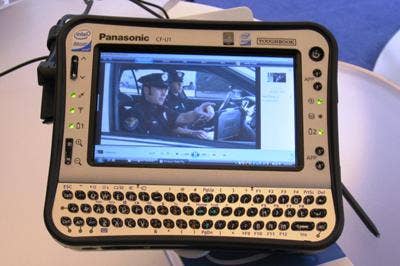
Mobile Internet Devices (MIDs) like this Panasonic Toughbook feature Intel's low-power Atom processor ... and the chip maker has put a lot on the line to market such ultra-mobile, Web-friendly computing devices to a wider audience. Intel CEO Paul Otellini made MIDs the centerpiece of his keynote at January's Consumer Electronics Show. The chip giant devoted a keynote and some prime Moscone real estate to the little buggers last week.

The Intel Developer Forum closed out with a do-it-yourself showcase based on the popular Maker Faire events in Austin, Tex. and San Mateo, Calif. A handful of DIY craftspeople and artists turned up Thursday afternoon to share their creations with IDF attendees ... and added some colorful, knocked-together chaos to this button-down event.
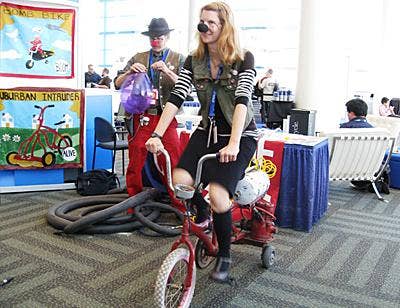
What can you say about pedal-pushing clowns bearing balloon animal gifts? It all depends on when the free beer runs out and the last taxi has left, we guess.
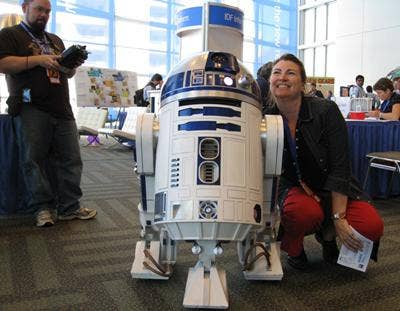
Chris James, a member of the Bay Area R2 Builders, controls this working replica of Star Wars "astromech droid" R2D2 as an IDF attendee poses with the little scrapper. The organization bills itself as "an international group of Star Wars fans who love to build droids."